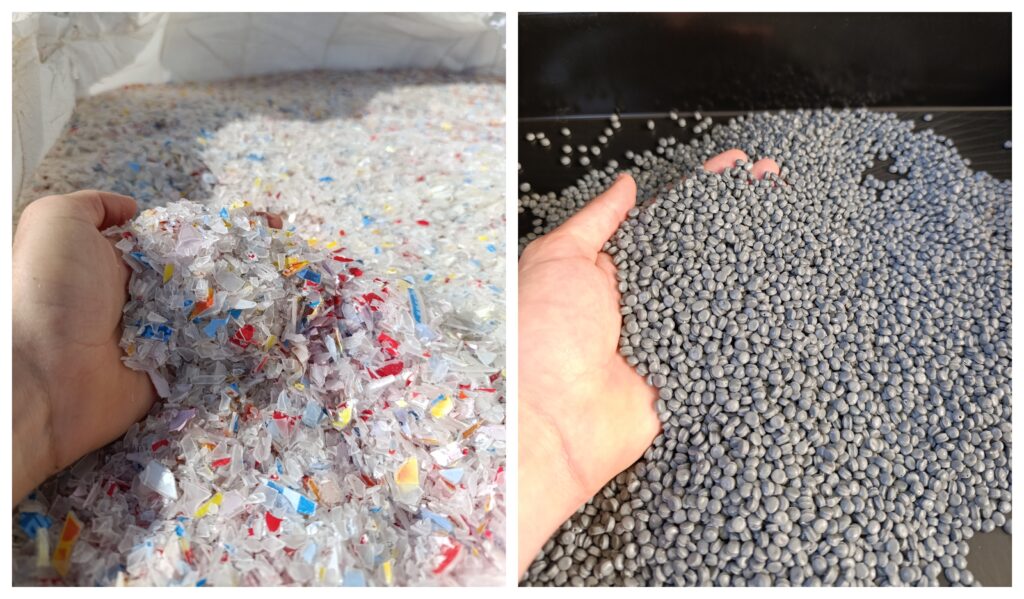Polypropylene and Polyethylene: Which is the Best Material?
At Murgiplast, we specialize in the manufacture of plastic flower pots and agricultural crates. To ensure the quality and durability of our products, we primarily use two types of plastics: polypropylene (PP) and polyethylene (PE). Although both are thermoplastic polymers widely used in industry, they have significant differences that make them more suitable for certain applications. Below, we explore their characteristics, advantages, and disadvantages to help you better understand these materials.
What are polypropylene and polyethylene?
Both polypropylene and polyethylene are thermoplastic polymers derived from hydrocarbons. Polyethylene is obtained through the polymerization of ethylene, while polypropylene comes from propylene. Both materials are recyclable and are used in a wide range of applications due to their versatile properties.
Property comparison
1. Thermal resistance
Polypropylene (PP): It has a higher melting point, between 160°C and 170°C, giving it excellent heat resistance. It is ideal for applications requiring sterilization or exposure to high temperatures.
Polyethylene (PE): Its melting point ranges from 105°C to 115°C, depending on its density. It is best suited for applications at moderate or low temperatures.
2. Resistance to low temperatures
Polypropylene (PP): It can become brittle at temperatures below 0°C. However, PP copolymers improve this property, maintaining ductility down to -40°C.
Polyethylene (PE): It stands out for its excellent performance at low temperatures, maintaining its flexibility even at -80°C.
3. Flexibility and impact resistance
Polypropylene (PP): It is stiffer and less flexible than PE, but offers greater resistance to fatigue and mechanical stress. It is difficult to tear, making it suitable for products requiring durability.
Polyethylene (PE): It's more flexible and elastic, allowing it to absorb impacts without breaking. It's ideal for applications where a certain degree of deformability is required.
4. Density and weight
Polypropylene (PP): It has a lower density (approximately 0.90–0.91 g/cm³), making it lighter than PE.
Polyethylene (PE): Its density varies between 0.91 and 0.97 g/cm³, depending on its type (low, medium or high density).
5. Chemical resistance
Polypropylene (PP): It offers excellent resistance to a wide range of chemicals, including acids and bases. It is suitable for applications involving exposure to corrosive substances.
Polyethylene (PE): It also has good chemical resistance, although slightly lower than that of PP in certain environments.
6. Transparency and color
Polypropylene (PP): Naturally translucent white, it can be easily colored. It offers a glossier finish and can be molded for greater transparency.
Polyethylene (PE): Generally colorless, it requires the addition of dyes to achieve specific shades. Its finish is more opaque compared to PP.
7. Recyclability
Both materials are recyclable and can be melted and molded repeatedly. However, polyethylene has a more established recycling infrastructure, making it easier to recover and reuse.
Applications in pots and agricultural boxes
Polypropylene (PP):
Advantages:
- High heat resistance, ideal for environments with high temperatures.
- Excellent chemical resistance, suitable for contact with fertilizers and pesticides.
- Greater rigidity and durability, prolonging the product's useful life.
Disadvantages:
- Less flexibility, which may limit its use in applications requiring deformability.
- It can become brittle at very low temperatures, although this can be mitigated with copolymers.
Polyethylene (PE):
Advantages:
- Excellent flexibility and impact resistance, ideal for handling and transport.
- Good behavior at low temperatures, suitable for storage in cold rooms.
- Lower cost, which can be beneficial for large-scale productions.
Disadvantages:
- Lower heat resistance, limiting its use in high temperature applications.
- Lower rigidity, which can affect structural stability in certain designs.
Conclusion
The choice between polypropylene and polyethylene depends on the specific needs of each application. At Murgiplast, we use both materials to offer products that combine durability, functionality, and efficiency. Our agricultural pots and crates are designed to meet the demands of the agricultural sector, ensuring optimal performance in a variety of conditions.
Do you have questions or need advice on which material is best suited to your needs? Contact us! We're here to help you find the best solution for your agricultural project.

